2006 Egypt
1 January 2007, Monday; Nubia House, Abu
Simbel, LE245 (incl)
We had a strange interaction at the bus
station tea shop soon after 07h00 this morning. We had ordered tea to go with
the street-bought pita and felafel and salad we had brought with for breakfast.
When we asked the price (having forgotten to do so before ordering and thinking
it should be LE3 each), we were told LE10. We said this was too expensive. “LE3
for one” said we. “LE4 for one”, said he. “Then LE8 for two”, said we. “No,
LE10 for two”, said he. I had to count it out on my fingers to show him 4+4=8.
We had been worried we would not get seats
on the 08h00 bus to Abu Simbel as we had been told these could not be booked in
advance. But our fears proved unfounded and by 08h00 we were seated, the only
tourists on the bus, for the four hour bus journey south to Abu Simbel near the
Sudanese border. Much later we passed the tourist convoy coming back from Abu
Simbel – buses and minibuses barrelling through the Sahara en masse.
At a tea stop in a barren spot, the women
remained on board as usual while the men went in to drink and snack – along
with Charl and I. Charl fell into conversation with an Abu Simbel hotel owner
(the one we had, in fact, been unable to reach by phone to make a reservation),
while I photographed kids off the bus.
We also chatted to a young man who told us
a little about the government’s project to pump water (and silt) from Lake
Nasser into canals along which new fields could be opened for cultivation. He
specialised in and was growing maize on one of these experimental farms. Our
hotel host later told us these canals would run for 800km, linking the oases to
the west, and would bring 1.5 million additional hectares under cultivation in
an effort to feed Egypt’s rapidly expanding population (74 million growing by 1
million every 10 months, he said).
After this tea stop conversation we looked
with new and interested eyes on the villages we passed thereafter – all newly
built with neat fields unexpected on the desert sands. Most seemingly empty,
though. All utilising solar power.
At one of the inevitable army posts we had
our first unpleasant(ish) encounter with an official – because Charl did not
respond to his greeting. “Hello”, he said again in a deliberate and threatening
manner – demanding (and getting) a response.
The first thing we noticed about Abu Simbel
was the bougainvillea – in shocking colours everywhere. Its really unusual to
see flowers blooming.
We enquired immediately about purchasing
bus tickets for the return journey at 06h00 on the morrow, and were told to
return to the local tea shop just there tonight at 21h00 where we would find
tomorrow’s bus driver under the tree! This proved later to be the case despite
our cynicism and our tickets were easily purchased from the driver / conductor
who took a quick break from drinking tea and playing backgammon with his
cronies.
We then checked into our wonderful Nubian
House hotel – absolutely charming with warm brown walls and Nubian art and open
arches onto a central courtyard and views of the lake and a charming and wicked
puppy. Owned and run by a Nubian couple concerned about the preservation of
their culture.
From there we strolled into town and found
a restaurant at which to have lunch. We were both overcharged and overfed, but
enjoyed our meal thoroughly. Charl says we “recapitalised” the owner’s shop as
he rushed out to buy tissues and other supplies just for us.
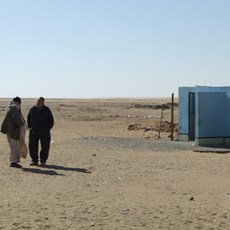
Loo and tea break
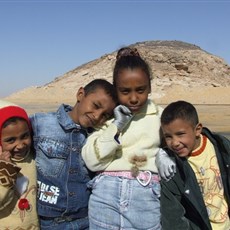
Loo and tea break
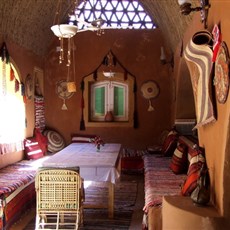
Nubian House
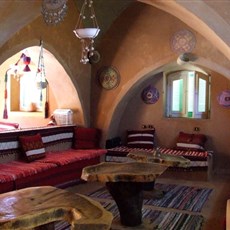
Nubian House
Then up the hill to visit the Ramses II temples – our raison d’être for being in town. En route we passed two signs, within 50m of each other, both spelling Abu Simbel incorrectly and differently from one another: Abu Simpel and Abu Sombol.
Ramses II facts
Ruled during the 19th Dynasty (1279-1212 BC).
Powerful and ambitious, he expanded Egypt’s empire and constructed many temples.
Parents: Queen Tuy and Seti I.
Came to the throne at age 20 and ruled for 67 years – the second longest-ruling Pharaoh.
Had a harem of wives (and over 100 children), but his special wife was Nefertari.
He fought to reclaim territory in Africa and Western Asia.
During his fifth year as Pharaoh, he led a campaign known as the Battle of Kadesh against the Hittites in (today’s) Syria.
Later, a treaty was signed, the territory was divided, and Ramses II agreed to marry the daughter of the Hittite King.
His love of architecture and power led him to erect more monuments and temples than any other Pharaoh.
Abu Simbel, probably Ramses II’s most impressive structure, was carved from a sandstone cliff that faced to the east. This was located in ancient Nubia.
Abu Simbel temple facts
Not only are the two temples at Abu Simbel (carved into a cliff in 13th century BC (1274-1244BC)) among the most magnificent monuments in the world but their removal and reconstruction was an historic event in itself.
When the temples (280 km from Aswan) were threatened by submersion in Lake Nasser, due to the construction of the High Dam, the Egyptian Government secured the support of UNESCO and launched a world wide appeal.
During the salvage operation which began in 1964 and continued until 1968, the two temples were dismantled and raised over 60 meters up the sandstone cliff where they had been built more than 3,000 years before.
Here they were reassembled, in the exact same relationship to each other and the sun, and covered with an artificial mountain. Most of the joins in the stone have now been filled by antiquity experts, but inside the temples it is still possible to see where the blocks were cut.
The temple, called the “Temple of Ramses, beloved of Amun”, was begun some time after his fifth regnal year, but not completed until his 35th regnal year.
The massive facade of the main temple is dominated by the four seated colossal statues of Ramses.
Each statue, 67 feet high, is seated on a throne and wears the double crown of Upper and Lower Egypt. All are sculpted directly from the rock face. The thrones are decorated on their sides with Nile gods symbolically uniting Egypt.
An ancient earthquake damaged the statues. One is demolished from the waist up.
Between the legs and on each of their sides stand smaller statues of members of the royal family.
Beneath these giant sculptures are carved figures of bound captives.
Within the temple a series of chambers become increasingly smaller as the floors of the rooms rise noticeably.
The first hall within the temple contains eight large statues of the king as Osiris, four on each side, which also serve as pillars to support the roof. The walls are decorated in relief with scenes showing the king in battle, including the great battle of Kadesh on the north, and Syrian, Libyan and Nubian wars on the south wall, and also presenting prisoners to the gods.
On the north entrance wall in this Hypostyle hall a scene shows Ramses in the presence of Amun, to whom the king appealed during his battle at Kadesh against the Hittites.
The sanctuary contains a small altar and in its rear niche are four statues. These cult images represent Ramses II and the three state gods of the New Kingdom, Ra-Horakhty of Heliopolis, Ptah of Memphis and Amun-Ra of Thebes. Before the statues rests a block upon which would have rested the sacred barque itself.
The axis of the temple is arranged so that on two days of the year, in February and October, the rising sun shoots its rays through the entrance and halls until it finally illuminates the sanctuary statues.
To the north of the main temple a smaller temple was built in honour of Ramses’ great wife, Nefertari, and the goddess Hathor.
As with Ramses’ own temple, the cliff face was cut back to resemble the sloping walls of a pylon. Six colossal standing figures 10m high four of Ramses and two of Nefertari (unusually at the same height as her husband), were cut from the rock face, along with smaller figures of the royal family. An inscription over the entrance reads “Ramses II, he has made a temple, excavated in the mountain, of eternal workmanship, for the chief queen Nefertari, beloved of Mut, in Nubia, forever and ever, Nefertari for whose sake the very sun does shine”.
Inside, Nefertari’s temple has a single Hathor-headed pillared hall. On the sides facing the centre of the hypostyle; Ramses is shown smiting his enemies and offering before various gods, while Nefertari is shown, graceful and slender, with hands raised. Three doors lead to a vestibule with ancillary rooms at either end.
The inner chamber contains a number of images interrelating the royal couple and the gods.
Nefertari is shown participating in the divine rituals on an equal footing with the king.
On the left wall, Nefertari is seen worshipping before Mut and Hathor, and on the right, Ramses worships before images of his deified self and his wife.
The two temples were absolutely stunning.
We managed to hitch a ride back to our hotel a few kilometres away and there fell into conversation with an Australian lawyer before a quick nap. Then walked / hitched back out to the temple for the evening sound and light show – the best part of which was simply seeing the temple faces simply lit at the end of the show. We walked / hitched home for dinner. Where we chatted to a British couple who both work for a company that is into alternative energy sources. She travels to developing countries and sets up the locals to plant and grow the oil seed plant (can’t remember which type) which the company buys back for fuel. And after booking our bus tickets we retired earlyish to bed. With a coffee flask and a packed breakfast ready for our early start.
After yet another superb day!
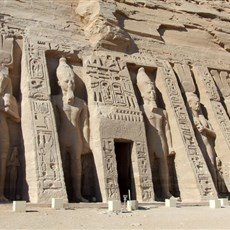
Abu Simbel temples
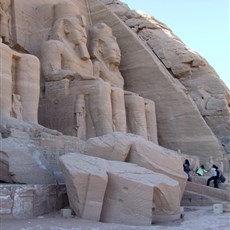
Abu Simbel temples
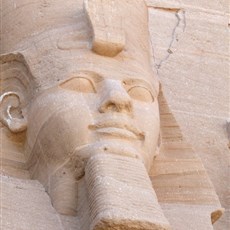
Abu Simbel temples
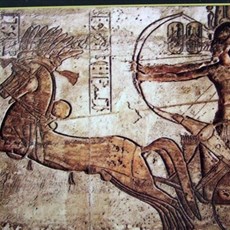
Abu Simbel temples (photo from postcard)
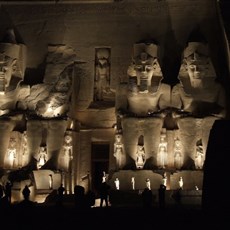
Abu Simbel temples